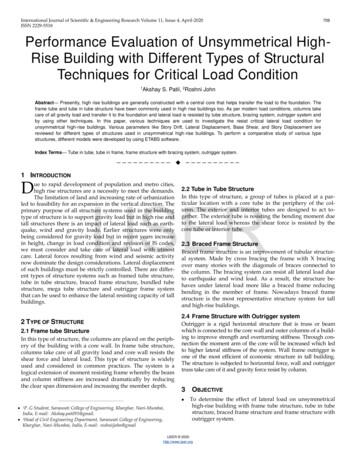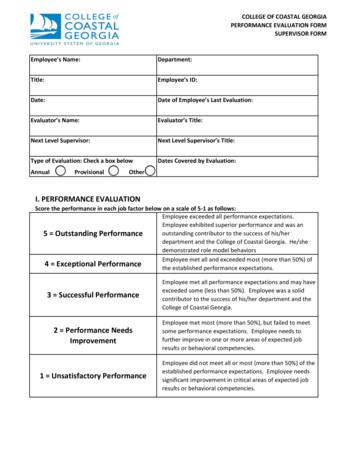Performance Evaluation Of Unsymmetrical High-Rise Building With .
International Journal of Scientific & Engineering Research Volume 11, Issue 4, April-2020 ISSN 2229-5518 709 Performance Evaluation of Unsymmetrical HighRise Building with Different Types of Structural Techniques for Critical Load Condition 1 Akshay S. Patil, 2Roshni John Abstract— Presently, high rise buildings are generally constructed with a central core that helps transfer the load to the foundation. The frame tube and tube in tube structure have been commonly used in high rise buildings too. As per modern load conditions, columns take care of all gravity load and transfer it to the foundation and lateral load is resisted by tube structure, bracing system, outrigger system and by using other techniques. In this paper, various techniques are used to investigate the resist critical lateral load condition for unsymmetrical high-rise buildings. Various parameters like Story Drift, Lateral Displacement, Base Shear, and Story Displacement are reviewed for different types of structures used in unsymmetrical high-rise buildings. To perform a comparative study of various type structures, different models were developed by using ETABS software. Index Terms— Tube in tube, tube in frame, frame structure with bracing system, outrigger system. —————————— —————————— 1 INTRODUCTION D ue to rapid development of population and metro cities, high rise structures are a necessity to meet the demands. The limitation of land and increasing rate of urbanization led to feasibility for an expansion in the vertical direction. The primary purpose of all structure systems used in the building type of structure is to support gravity load but in high rise and tall structures there is an impact of lateral load such as earthquake, wind and gravity loads. Earlier structures were only being considered for gravity load but in recent years increase in height, change in load condition and revision of IS codes, we must consider and take care of lateral load with utmost care. Lateral forces resulting from wind and seismic activity now dominate the design considerations. Lateral displacement of such buildings must be strictly controlled. There are different types of structure systems such as framed tube structure, tube in tube structure, braced frame structure, bundled tube structure, mega tube structure and outrigger frame system that can be used to enhance the lateral resisting capacity of tall buildings. IJSER 2.2 Tube in Tube Structure In this type of structure, a group of tubes is placed at a particular location with a core tube in the periphery of the column. The exterior and interior tubes are designed to act together. The exterior tube is resisting the bending moment due to the lateral load whereas the shear force is resisted by the core tube or interior tube. 2.3 Braced Frame Structure Braced frame structure is an improvement of tubular structural system. Made by cross bracing the frame with X bracing over many stories with the diagonals of braces connected to the column. The bracing system can resist all lateral load due to earthquake and wind load. As a result, the structure behaves under lateral load more like a braced frame reducing bending in the member of frame. Nowadays braced frame structure is the most representative structure system for tall and high-rise buildings. 2.4 Frame Structure with Outrigger system 2 TYPE OF STRUCTURE 2.1 Frame tube Structure In this type of structure, the columns are placed on the periphery of the building with a core wall. In frame tube structure, columns take care of all gravity load and core wall resists the shear force and lateral load. This type of structure is widely used and considered in common practices. The system is a logical extension of moment resisting frame whereby the beam and column stiffness are increased dramatically by reducing the clear span dimension and increasing the member depth. Outrigger is a rigid horizontal structure that is truss or beam which is connected to the core wall and outer columns of a building to improve strength and overturning stiffness. Through connection the moment arm of the core will be increased which led to higher lateral stiffness of the system. Wall frame outrigger is one of the most efficient of economic structure in tall building. The structure is subjected to horizontal force, wall and outrigger truss take care of it and gravity force resist by column. 3 ———————————————— 1P. G Student, Saraswati College of Engineering, Kharghar, Navi-Mumbai, India, E-mail: Akshay.patil91@gmail. 2Head of Civil Engineering Department, Saraswati College of Engineering, Kharghar, Navi-Mumbai, India, E-mail: roshnijjohn@gmail OBJECTIVE To determine the effect of lateral load on unsymmetrical high-rise building with frame tube structure, tube in tube structure, braced frame structure and frame structure with outrigger system. IJSER 2020 http://www.ijser.org
International Journal of Scientific & Engineering Research Volume 11, Issue 4, April-2020 ISSN 2229-5518 Comparative analysis between frame tube structure, tube in tube structure, braced frame structure and frame structure with outrigger system. To study the lateral story displacement, story drift, and base shear for frame tube structure, tube in tube structure, braced frame structure and frame structure with outrigger system. Results compared between the unsymmetrical high-rise structure. To rectify the most vulnerable building among the models considered for lateral load condition. all four types of 4 METHODOLGY A G 43 story unsymmetrical high-rise building was considered in this study. Four models were modelled and analyzed using ETABS Software. Typical floor plan and elevation is shown below. 710 5 MODELLING AND ANAYLSIS 5.1 Frame tube Structure Tube in tube structure. Frame structure with outrigger system. Braced frame structure. Frame tube structure. 5.2 Input Parameter A G 43 high rise building with asymmetric plan modeled in this study. Material properties of each element are discussed below. Four models were analyzed and effect due to static and dynamic earthquake load was determine. TABLE 1 INPUT PARAMETER Sr no. Particular Dimension 1 Floor dimension X-direction 75 m 2 3 4 Floor dimension Y-direction Spacing between frame Beam size 75 m 5m 230 mm X 600 mm 5 Column size 300 mm X 1500 mm IJSER Fig. 1. Plan of Model Fig. 3. 3D View of Tube in Tube structure Fig. 2. 3D View of Model IJSER 2020 http://www.ijser.org
International Journal of Scientific & Engineering Research Volume 11, Issue 4, April-2020 ISSN 2229-5518 711 TABLE 2 MATERIAL PROPERTIES Sr no. 1 2 3 4 5 Particular Concrete Steel Youngs modulus of steel Es Youngs modulus of concrete Ec Yield stress of steel Dimension M:40 Fe 500 210000 MPa 31622.77 MPa 500 MPa 6 Ultimate strain 0.0035 TABLE 3 LOAD CONSIDERATION Fig. 4. 3D View of Frame Structure with Outrigger System Sr no. Load type Value 1 Live load 2 kN/m2 2 3 Floor finish load 230 mm Thik Wall load 1.5 kN/m2 13.8 kN.m TABLE 4 SEISMIC PARAMETER Sr no. 1 2 3 4 5 Load type Seismic zone Zone factor Response reduction factor, R Soil type Important factor IJSER Value III 0.16 5 II 1.2 TABLE 4 WIND PARAMETER Fig. 5. 3D View of Braced Frame Structure Sr no. 1 2 3 4 5 6 Load type Wind speed (Vb) Terrain category Risk co-efficient (K1) Topography (K3) External co-efficient Internal co-efficient Value 39 m/s 2 1 1 0.8 0.5 6 RESULTS The results found plotted to get actual behavior of structure and judge the objective of study. The result and their significance discussed here briefly. 6.1 Lateral Displacment Fig. 6. 3D View of Frame Tube Structure From the results studied, we can observe that when the G 43 story models are subjected to a dynamic earthquake in Xdirection the maximum top story displacement of the structure with conventional SMRF system is observed to be 490.56 mm while 386.54 mm in tube in tube structure. 351.48 mm in frame structure with outrigger system and minimum displacement observed in braced frame structure which is 226.37 mm. Hence, a reduction up to 40% is achieved by introducing X-bracing at the end of structure. Similarly, a reduction of up to 35-40% is observed due to application of seismic force along Y-direction by using bracing system as compared to conventional system. IJSER 2020 http://www.ijser.org
International Journal of Scientific & Engineering Research Volume 11, Issue 4, April-2020 ISSN 2229-5518 712 6.3 Story Drift From the results studied after a 129 m high rise building is subjected to seismic load along X-direction, it is noted that story drift at 48 m level and 77 m level is reduced by 48% to 52 % due to outrigger truss at 0.4 h and 0.6h. However, story drift is less in braced frame structure compare to tube in tube structure, and frame tube structure. Fig. 7. Max. Lateral Displacment in X-direction Fig. 10. Story Drift IJSER 6.4 Time Period From the results, it is observed that providing X-bracing at the end of structure reduces the time period as compared to tube in tube structure, frame structure with outrigger system and frame tube structure. In mode-I, there is a reduction of about 15% to 20% in the time period of the X-bracing system compared to other three structures. Fig. 8. Max. Lateral Displacment in Y-direction 6.2 Base Shear A small increase is seen in base shear when structure is subjected to earthquake load. This small increase in base shear along both directions is due to the increase in self weight of outrigger truss and X-bracing system. Fig. 10. Time Period 7 CONCLUSION Fig. 9. Base Shear The analysis of four different types of structure were carried out using the ETABS software. The behavior of each model is studied, and the results are tabulated. The various parameters like lateral displacement, Base shear, Story drift and natural time period have been studied for dynamic analysis method. The results of all models are observed, and the most suitable model is selected by comparing the results of each model. IJSER 2020 http://www.ijser.org
International Journal of Scientific & Engineering Research Volume 11, Issue 4, April-2020 ISSN 2229-5518 From the modular investigation it can be inferred that lateral displacement of braced frame structure decreases by 40% due to introduction of X-bracing system in frame structure. Lateral displacement is less than tube in tube structure, Frame structure with outrigger system and frame tube structure. There has been a small increase in base shear in the X-bracing system. This is due to the addition of self-weight of XBracing in the structure. Similarly, base shear is greater in the outrigger system compared to frame tube structure and tube in tube structure due to additional self-weight of the outrigger system. Time period considerably decreases by 15% to 20% due to introduction of X-bracing in frame structure. Time period in braced frame structure is comparatively less than tube in tube structure, frame structure with outrigger system and frame tube structure. From the results studied, when a 129 m high rise building is subjected to seismic load along X-direction, it noted that the story drifts at 48 m level and 77 m level are reduced by 48% to 52 % respectively due to outrigger truss at 0.4 h and 0.6h. However, story drift is less in braced frame structure compared to tube in tube structure, and frame tube structure. [7] [8] [9] [10] [11] [12] International journal of engineering and advance technology, IJEAT Vol-06, Issue- Aug. 2017, PP 2249-8958. Mr. K. Lovaraju, Dr. K.V.G.D Balaji, “Effective location of shear wall on performance of building frame subjected to earthquake load” International advance research journal in science, engineering and technology research, IARJSET Vol-02, Issue 1st Jan 2015, PP-2394-1588. Mohammad Tabrez, Kiran K.M, “Analysis of tube in tube structure with different size of inner tube” International journal of technical innovation of modern engineering and science, IJTIMES Vol-04, Issue- 10th Oct. 2018, PP 2455-2585. Nimmy Dileep, Renjit R. “Analytical investigation on the performance of tube in tube structure subjected to lateral load” International journal of technical research and application, IJTERA, Vol-03, Issue Aug 2015, PP 284-288. Pillatla Ranga Sri, S. Uttam Raj, “Lateral load analysis of shear wall framed multisotry structure for achieving more safety towards earthquakes” International journal and magazine of engineering, technology, management and research, IJTERA, PP 2348-4845. Akbar.A, Azeez.S “Effect of outrigger system in multi storied irregular building” International journal of modern trends in Engineering and Research, Vol03, Issue 07, pp.197-203 (2016) Badami S, Suresh M.R “As Study on Behavior of structure system for Tall Building Subjected to Lateral Load” International Journal of Engineering Research and Technology (IJERT), Vol-03, Issue 7, pp989-994 (2014) Gadkari A.P, Gore N.G, “Review on Behavior of Outrigger Structural System in High Rise Building” International Journal of Engineering Development and Research. Vol-04, Issue-2. Pp 2065-2073 (2016). IJSER After comparisons. it is found that braced frame structure performs better in dynamic load condition compared to tube in tube structure, frame structure with outrigger system and frame tube structure. From the comparison of analysis results, braced frame structure is recommended as a better structure system of high-rise building than other the three types of structure. Hence, provision of a X-bracing position in an appropriate location is advantageous for better performance in dynamic load condition. [13] References [1] [2] [3] [4] [5] [6] 713 Bipin Naik, B.S Suresh Chandra, “Comparative analysis between tube in tube structure and conventional moment resisting frame” International research journal of engineering and technology (IRJET), Vol-04, Issue 10th oct 2017, PP 2395-0072. Archana J, Reshmi P.R,” Comparative study on tube in tube structure and tubed mega frames” International research journal of innovation research in science engineering and technology, Vol-05, Issue 8th August 2016, PP 23476710. Abhishek, Smitha B.L “Comparative study of tube in tube structure and tubed mega frames” International journal of recent Trent in science engineering and technology, IJRTER Issue- 2018, PP 2455-1457. Hardik Patel, A.R Darji, “Braced tube structure review” International journal of scientific and engineering research, IJSER Vol-06, Issue 12th dec 2015, PP2229-5518. R. Ramasubramani, G. Pennarasi, “Differential settlement in various tubular structural system” International journal of recent Trent in science engineering and technology, IJRTER Vol-08, Issue- 4th Nov. 2019, PP 2277-3878. Vinay Agarwal, Rajesh Gupta, Manisg Goyal, “A study on seismic Analysis of high-rise irregular floor plan building with different position of shear wall” IJSER 2020 http://www.ijser.org
tube in tube structure, braced frame structure, bundled tube structure, mega tube structure and outrigger frame system that can be used to enhance the lateral resisting capacity of tall buildings. 2 TYPE OF STRUCTURE 2.1 Frame tube Structure In this type of structure, the columns are placed on the periph-ery of the building with a core wall.
Precast, prestressed concrete unsymmetrical sections have been employed in the past with various degrees of success. The challenge of two-directional camber at time of prestress re lease and the complexity of stress calculations have discouraged widespread application. The con cept, however, has been success fully applied to stadium risers.4
This paper investigates the short-circuit behavior of a WPP for different types of s. Both symmetrical faults wind turbine and unsymmetrical faults investigated. Three different sofare t-ware packages utilizedare to develop this paper. Time domain simulations and steady-state calculations are used to perform the analysis.
Performance Evaluation Plan Reference Annex XIII 1. ‘ To plan, continuously conduct and document a performance evaluation, the manufacturer shall establish and update a performance evaluation plan. The performance evaluation plan shall specify the characteristics and the perfor
POINT METHOD OF JOB EVALUATION -- 2 6 3 Bergmann, T. J., and Scarpello, V. G. (2001). Point schedule to method of job evaluation. In Compensation decision '. This is one making. New York, NY: Harcourt. f dollar . ' POINT METHOD OF JOB EVALUATION In the point method (also called point factor) of job evaluation, the organizationFile Size: 575KBPage Count: 12Explore further4 Different Types of Job Evaluation Methods - Workologyworkology.comPoint Method Job Evaluation Example Work - Chron.comwork.chron.comSAMPLE APPLICATION SCORING MATRIXwww.talent.wisc.eduSix Steps to Conducting a Job Analysis - OPM.govwww.opm.govJob Evaluation: Point Method - HR-Guidewww.hr-guide.comRecommended to you b
Section 2 Evaluation Essentials covers the nuts and bolts of 'how to do' evaluation including evaluation stages, evaluation questions, and a range of evaluation methods. Section 3 Evaluation Frameworks and Logic Models introduces logic models and how these form an integral part of the approach to planning and evaluation. It also
PERFORMANCE EVALUATION FORM SUPERVISOR FORM I. PERFORMANCE EVALUATION Score the performance in each job factor below on a scale of 5-1 as follows: Type of Evaluation: Check a box below Dates Covered by Evaluation:
Formal annual evaluation of performance The formal annual evaluation of employee performance and planning development comprises four parts: 1. Identifying and agreeing on Key Performance Indicators, and any goals and responsibilities to implement the service's QIP. 2. Preparing for the meeting. 3. The annual performance evaluation meeting. 4.
Operation Guide for the Mercedes-Benz GLA/CLA This is a basic operation guide for those who are driving the Mercedes-Benz GLA/CLA vehicle for the first time. Please read this guide before you leave the rental office if you are not familiar with operation. For more information about the vehicle, please read the instruction manual. Basic Operations to Note Before Driving the Vehicle Starting .























